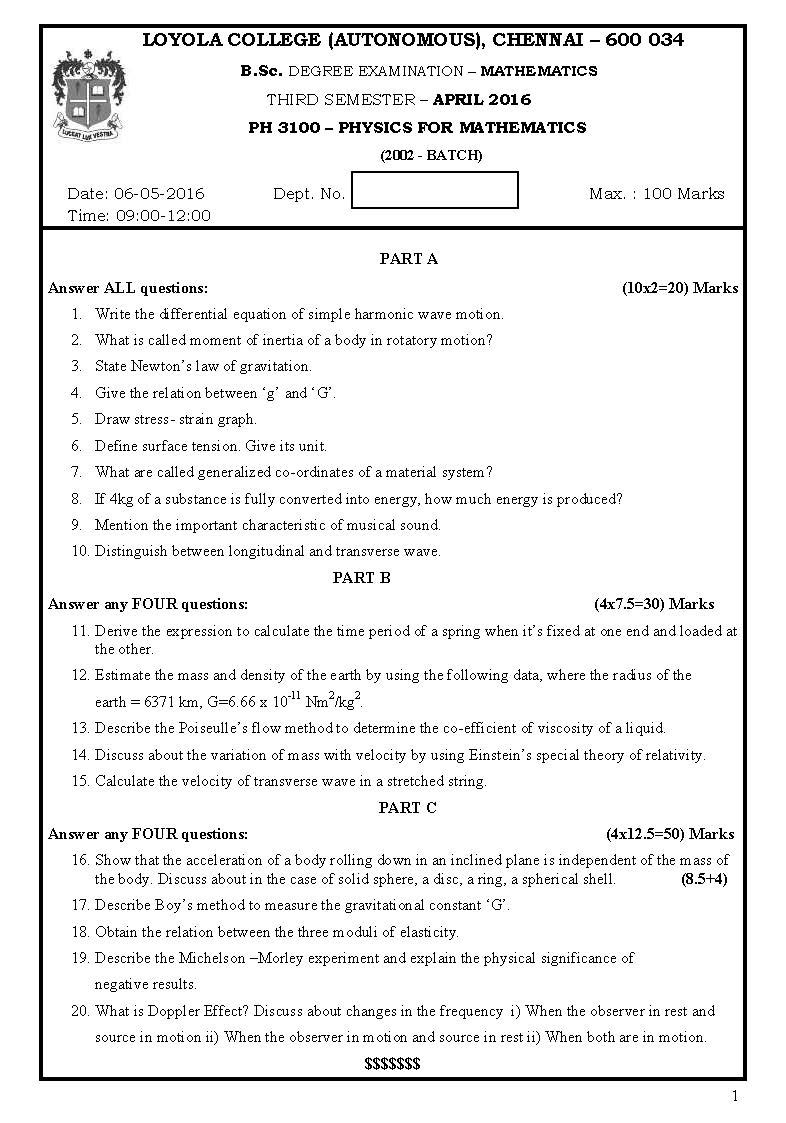LOYOLA COLLEGE (AUTONOMOUS), CHENNAI – 600 034 B.Sc. DEGREE EXAMINATION – MATHEMATICS
|
THIRD SEMESTER – NOV 2006
PH 3100 – PHYSICS FOR MATHEMATICS
(Also equivalent to PHY 100)
Date & Time : 28-10-2006/9.00-12.00 Dept. No. Max. : 100 Marks
PART A
Answer ALL questions: 10 x 2 = 20 marks
- State Principle of Conservation of angular momentum.
- Give an expression for angular acceleration.
- State Newton’s law of Gravitation.
- What is parking orbit?
- Define Poisson’s ratio.
- Explain the term viscosity of a fluid.
- State the fundamental postulates of the special theory of relativity.
- Explain the term ‘frame of reference’.
- What are beats? How are they produced?
- The driver of a car moving towards a factory with velocity 30 m/s sounds the horn with a frequency of 240 Hz. Find the apparent frequency of sound heard by the watchman of the factory.
PART B
Answer any FOUR questions: 4 x 7.5 = 30 marks
- Prove that the oscillation of a liquid in a U-tube is simple harmonic.
- Using Newton’s law of gravitation calculate (a) mass and density of earth (b) mass of sun [given G = 6.67 x 10-11 Nm2 Kg-2; Radius of earth = 6.38 x 106 m and distance of earth from centre of the Sun = 1.5 x 1011
- Obtain Stoke’s law for the motion of body in a viscous medium from dimensional considerations. Also determine the Coefficient of viscosity of a liquid from Stoke’s formula.
- On the basis of Lorentz transformation, derive an expression for length contraction.
- Explain Doppler Effect. Derive a general expression for the apparent frequency of a note when both the source and the listener are in motion.
PART C
Answer any FOUR questions: 4 x 12.5 = 50 marks
- Explain simple harmonic motion and discuss its characteristics. Derive Simple Harmonic equations by calculus.
- What is stationary satellite? Define escape velocity. Show that the escape velocity from the surface of the earth is equal to 11 km/s. Distinguish between orbital velocity and escape velocity.
- Define Young’s modulus, modulus of rigidity and Poisson’s ratio. Show that the bulk modulus of elasticity K = Y / [3(1-2σ)].
- Describe Michelson-Morley experiment. Discuss the results obtained.
- What is resonance? Explain the resonance column find the velocity of sound in air.
